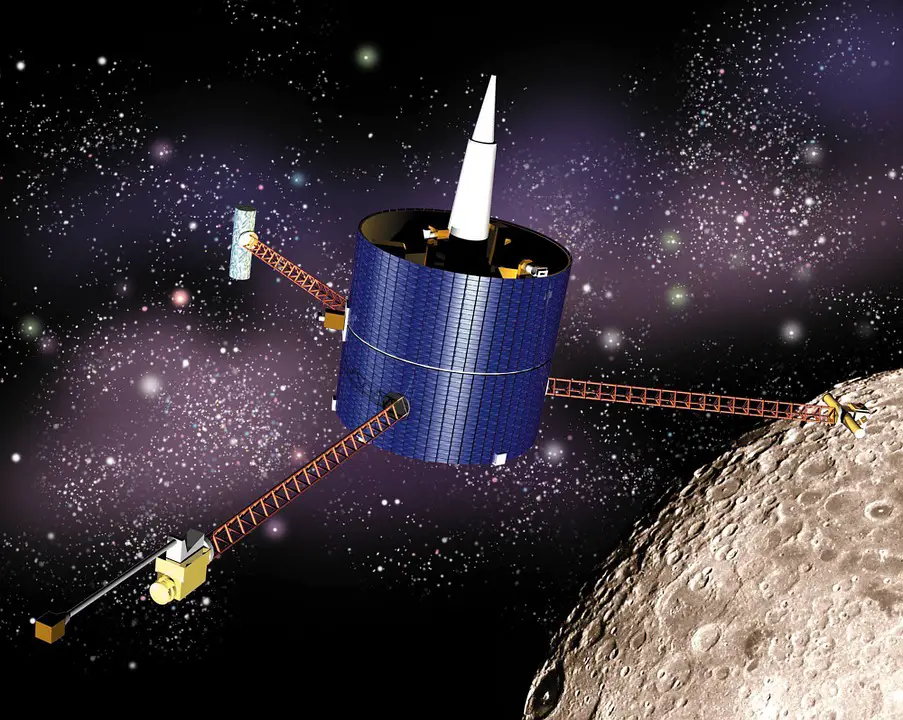Introduction
NASA has consistently been one step ahead of the competition in terms of conducting ground-breaking space exploration missions. The Lunar Prospector mission was a daring and one-of-a-kind endeavor that attracted the attention of people all around the world. This achievement is just one of several that the mission achieved. Instead of conducting a typical mission with the goal of successfully landing a spacecraft on the surface of the Moon, NASA planned the Lunar Prospector to intentionally crash on the lunar surface. This was not an act of irresponsibility on anyone’s part; rather, it was part of a mission that had been meticulously organized with particular objectives and scientific goals. In this essay, we look into the reasoning behind NASA’s decision to construct the Lunar Prospector spacecraft for a controlled lunar impact. We do this by analyzing the data that was collected during the mission.
Investigating the Unknown Facets of the Moon
The Lunar Prospector mission was initiated on January 6, 1998, with the goal of collecting important data on the celestial body that is located closest to the Earth. Scientists thought that by investigating the geology, composition, and magnetic fields of the Moon, they would be able to gain crucial insights on the Moon’s beginnings, formation, and development. Not only is an understanding of the Moon necessary for our knowledge of the solar system as a whole, but it is also necessary because of the Moon’s prospective role as a launch pad for future space travel and colonization.
Mapping the Resources of the Moon
The Lunar Prospector mission set out to accomplish a number of key goals, one of the most important of which was to locate and map the distribution of significant resources on the Moon. The presence of water ice, which had the potential to support future human settlements and serve as a lucrative resource for the manufacture of fuel, was of special interest to scientists. The objective of the Lunar Prospector mission was to purposely crash the spacecraft into a polar region of the Moon in order to generate debris that could provide critical information regarding the presence and amount of water ice as well as other volatile chemicals.
Determining the Constituents of the Moon
The instruments on board the spacecraft were developed with the express purpose of determining the make-up of the Moon. The Lunar Prospector collected data on the amount of several elements, including as hydrogen, helium, and a variety of metals, by analyzing both the surface and the subsurface of the moon. With the use of these observations, scientists were able to get a deeper comprehension of the geology of the Moon as well as its connection to the Earth.
Measuring Lunar Magnetism
A magnetometer was included on the Lunar Prospector so that scientists could investigate the magnetic fields of the moon. Understanding the magnetic characteristics of the Moon has provided scientists with important knowledge about the Moon’s interior as well as the possibility of the existence of a lunar dynamo. Researchers wanted to find out more about the Moon’s early history and how it interacted with the solar wind, so they focused their attention on researching these fields.
The Lunar Prospector’s Continuing Legacy
In spite of the fact that the spacecraft was designed to purposefully crash onto the surface of the Moon on July 31, 1999, the Lunar Prospector mission had a significant and long-lasting impact on lunar exploration and our knowledge of the Moon. The data collected by the mission made a significant contribution to the discoveries made by succeeding lunar missions, such as the Lunar Reconnaissance Orbiter (LRO) and the Chandrayaan-1 mission carried out by the Indian Space Research Organization (ISRO). The information that was gathered by the Lunar Prospector cleared the way for future lunar exploration programs, such as NASA’s Artemis mission, which has the goal of establishing a human presence on the Moon that is both sustainable and self-sufficient by the end of the decade.
Conclusion
The need to collect vital scientific data about our nearby celestial neighbor was the impetus behind the decision made by NASA to purposefully crash the Lunar Prospector spacecraft onto the Moon. Scientists hoped that by studying the geology, composition, and magnetic fields of the Moon, they would be able to discover the Moon’s history, evolution, and the potential resources it could provide. The audacious mission that the Lunar Prospector undertook yielded important discoveries and established a firm foundation for future exploration and comprehension of the Moon. Such bold projects serve as a monument to human ingenuity and our unwavering commitment to uncovering the mysteries of the universe as we continue to broaden our understanding of the cosmos.
![]()
